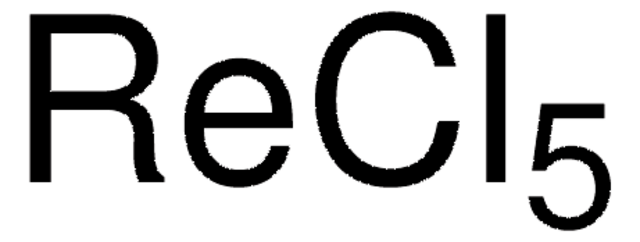520640
Platinum(IV) chloride
≥99.9% trace metals basis
Sinónimos:
Platinum tetrachloride
About This Item
Productos recomendados
Análisis
≥99.9% trace metals basis
formulario
powder
composición
Pt, 55-58%
idoneidad de la reacción
reagent type: catalyst
core: platinum
impurezas
≤1000.0 ppm Trace Metal Analysis
mp
370 °C (dec.) (lit.)
densidad
4.303 g/mL at 25 °C (lit.)
cadena SMILES
Cl[Pt](Cl)(Cl)Cl
InChI
1S/4ClH.Pt/h4*1H;/q;;;;+4/p-4
Clave InChI
FBEIPJNQGITEBL-UHFFFAOYSA-J
¿Está buscando productos similares? Visita Guía de comparación de productos
Descripción general
Aplicación
Platinumnanoparticles can be synthesized by reacting platinum (IV) chloride with Cyanobacteriumin an environmentally friendly method.
It can also be used as a dual catalyst forstereo- and regioselective glycosidations. Due to its ligand-bindingcapacity, platinum (IV) chloridehas an affinity for the glycosyl acceptor hydroxy group and forms the glycosidationproduct in β-configuration. It also enhances nucleophilicity differencesbetween hydroxy groups allowing regioselective glycosidation.
Palabra de señalización
Danger
Frases de peligro
Consejos de prudencia
Clasificaciones de peligro
Acute Tox. 3 Oral - Eye Dam. 1 - Resp. Sens. 1 - Skin Corr. 1B - Skin Sens. 1
Código de clase de almacenamiento
6.1A - Combustible acute toxic Cat. 1 and 2 / very toxic hazardous materials
Clase de riesgo para el agua (WGK)
WGK 2
Punto de inflamabilidad (°F)
Not applicable
Punto de inflamabilidad (°C)
Not applicable
Equipo de protección personal
Eyeshields, Faceshields, Gloves, type P3 (EN 143) respirator cartridges
Certificados de análisis (COA)
Busque Certificados de análisis (COA) introduciendo el número de lote del producto. Los números de lote se encuentran en la etiqueta del producto después de las palabras «Lot» o «Batch»
¿Ya tiene este producto?
Encuentre la documentación para los productos que ha comprado recientemente en la Biblioteca de documentos.
Los clientes también vieron
Artículos
Plasmonic nanoparticles have unique optical properties that can be tailored to suit a variety of applications in the biotechnology1–8 and electronics9–16 industries.
Nuestro equipo de científicos tiene experiencia en todas las áreas de investigación: Ciencias de la vida, Ciencia de los materiales, Síntesis química, Cromatografía, Analítica y muchas otras.
Póngase en contacto con el Servicio técnico










![[Pd(OAc)2]3 99.98% trace metals basis](/deepweb/assets/sigmaaldrich/product/structures/508/249/99a0ef2c-b77c-4d73-8ed9-0cca05b6b41f/640/99a0ef2c-b77c-4d73-8ed9-0cca05b6b41f.png)

